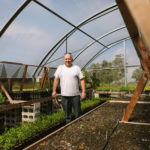Local jam maker Etsuko Ono makes do with foraged fruits.
Today is jam day. In the kitchen, calamansi simmers in a 10-quart stock pot. Etsuko Ono, who flits around the room with Mary Poppins-like grace, bends over the stove, carefully stirring the mixture to keep it from sticking to the bottom. The smell of citrus and sugar clings to everything.
She picks up a jar of cardamom and pops it open. “Time for my favorite part,” she says as she sprinkles a handful of seeds into the pot. Upon contact, a rich aroma blooms. The scent is warm and all-encompassing. Later, when the juices and pulps have thickened into a marmalade, Ono lets me have a taste. The strong tang of calamansi melds with the cardamom’s subtly spicy sweetness. It’s poetry in flavors.
A chalkboard hints at Ono’s other combinations: cranberry and orange, mango and lime, pine and liliko‘i, and liliko‘i butter. On the matter of liliko‘i, Ono invites me outside to help harvest. The front yard of her Hawai‘i Kai cottage is dedicated to fruits for her jams. There are yet-to-bloom Surinam cherry and lemon trees.
Liliko‘i vines crawl along the fence, passionfruit dangling sumptuosly from their canopy. Strolling through her yard, Ono pauses constantly, softly exclaiming whenever she finds a fruit that has fallen on the ground.
Soon, her arms are overflowing with produce ready to become jams, preserves, and confitures for her homemade jam company, Ohana Jam.
I thought it was such a waste. There were these beautiful fruits that nobody was going to eat.


As we chat in her front yard, Ono points out three neighbors who regularly supply her with enough fruit for several weeks’ worth of jam; she sources most of her fruits from her or her neighbors’ yards. Other fruits are bought directly from growers via farmers markets, where Ono can also be found selling her jams. Occasionally, Ono will hike into the mountains to forage.
Foraging was how Ono got started with jam-making. Originally from Japan, she moved to Hawai‘i with her husband, Kyle Ono, in 1996. Kyle, a nature guide, took Etsuko on hikes throughout O‘ahu. She saw the abundance of fallen fruits scattered on the forest floor.
“I thought it was such a waste,” she says. “There were these beautiful fruits that nobody was going to eat.”
She gathered those fresh enough to eat and brought them home. She transitioned the hobby into a business after a successful pop-up at a 2011 fundraiser for Japan’s tsunami relief.
Eventually, Etsuko left her job as a chief graphic designer for Clarence Lee Designs to pursue jam-making full-time.
For Etsuko Ono, preservation was a gut instinct cultivated from her childhood in Japan. She recalls memories of her family’s homesteading ways, storing fruits and vegetables in their pickled or fermented forms.
“I think it used to be like that in America too,” she says, chuckling softly before adding, “like Little House on the Prairie.”




Before there was industrialized food production, supermarket chains, and refrigeration, food preservation was a means of survival. Extending food’s shelf-life often required curing, pickling, fermenting, and jellying. It necessitated an intimate relationship with one’s food; a slowing and familiarizing. Some practices, like pickling and fermenting, are time extensive. “You need a lot of patience,” Ono says. Even her preferred method of jellying, one of the quicker preservation processes, requires at least half a day of production.
Today, crowd-favorite flavors like pineapple-liliko‘i and pink guava routinely sell out at her weekly stand at the Kaka‘ako Farmers Market. Despite the growing demand, Ono keeps her production in small batches. It’s partly because of manpower; she makes all of her jams by hand and on her own. But it’s also to ensure quality, ascribing to her own mantra of “making do with what we have.”
Self-sufficiency as a lifestyle has seen a resurgence in recent years, particularly among the environmentally conscious—a response to ecological damage caused by contemporary industries.
A 2016 Penn State study, “The Resurgence of Homesteading,” documented the rise of a bucolic, back-to-land means of living, exhibited by a repopularizing of farmers markets, urban gardens, and artisan crafts like jam- and jelly-making.
For Ono, preservation is an easy entry point for other self-sufficient practices. “In Hawai‘i, we try to live the same way as people on the Mainland,” she says, “but we’re in the middle of the Pacific Ocean. We don’t have the same natural resources; we import everything. So, using the fruits in my yard or from the mountains makes sense to me.”
Spring and summer is when most of Hawai‘i’s trees fruit, often yielding more produce than we know what to do with. Ono recommends preserving this bounty in jams and confitures, letting you enjoy their sweetness for months after.
How to Make Jam
Spring and summer is when most of Hawai‘i’s trees fruit, often yielding more produce than we know what to do with. Ono recommends preserving this bounty in jams and confitures, letting you enjoy their sweetness for months after.


- Prepare fruit. Cut into large squares. For fruit with thick skins, separate the pulp. More fruit means more jam.
- Combine fruit and sugar in a pot. Sugar needs to be about 40 to 60 percent of the weight of the fruit.
- Cook at high heat until desired consistency is reached, stirring often to keep mixture from sticking to pot. Test for proper consistency by spreading a thin layer of it on a baking tray. Tilt the tray slightly. If jam does not run, then it is ready. Add lemon juice, spices, or liquor such as rum and brandy to give depth of flavor.
- Pack in heat-proof glass jars. To prolong shelf life, place jars in boiling water for 10 to 12 minutes to sterilize before filling.


